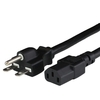What is a Grounding Conductor and Why Do Power Cords Have Them?
Created on: Aug 14, 2024
What is a Grounding Conductor and Why Do Power Cords Have Them?
The purpose of grounding conductors is to provide the path of least resistance from the electrical source back to the ground. Properly sized grounding conductors protect personnel from electric shock. In order to understand how grounding conductors work, you must first understand how they came to be.
History
The history of grounding conductors can be traced all the way back to the 1750s, when the lightning rod was invented by both Benjamin Franklin and Prokop Davis.
While conducting experiments on electricity in his home laboratory, Benjamin Franklin accidentally shocked himself. He began to think about the need to protect both people and buildings from lightning, leading to his invention of the lightning rod in 1752.
Similarly, Prokop Davis invented the first grounded lightning rod in the 1750s around the same time, after hearing that George Wilhelm Richmann, a professor at St. Petersburg at the time, was killed by lightning while observing a storm from a hut.
Centuries later, the first electromagnetic telegraph systems were invented. From 1820 onwards, they required two or more wires to carry a signal and return currents. Between 1936 and 1937, German scientist Carl August Steinheil discovered that the ground could be used as a return path to complete the circuit.
For all three scientists, the intention was the same. To protect both people and surrounding structures, a path was needed to connect positively charged energy to the negatively charged ground. In turn, the positively charged energy would return to its source.
Grounding Conductor Specifications and Requirements
The National Electrical Code provides a list of guidelines for the safe installation of electrical wiring and equipment.
Here is a list of the most important specifications and requirements for safe installation:
Grounding wire must be either a green bare wire or green with yellow insulation.
Grounded wire must be white or grey in color on the customer side. On the utility side, they do not usually have insulation.
Equipment grounded conductors (EGCs) can be made of copper, aluminum, or copper-clad aluminum material.
All connections and joints should be tightened with suitable tools, or risk faulty operation of overcurrent devices.
Fittings, such as cable trays or raceway, must be suitable for use with the type of installed writing method chosen.
Grounding vs. Grounded
Understanding the difference between grounding vs. grounded wires aides in avoiding potentially dangerous situations. While grounded wires are used under typical operating circumstances, grounding wires serve as a kind of back up.
Grounding wires are connected directly to the earth. In case of a faulty condition, they guide electricity back to its source, so that it does not go to an appliance or anyone in contact with one.
In terms of color, bare or green wires represent grounding, while white and grey represent grounded.
Grounded conductors are also referred to as neutral when a circuit has one or more hot wire.
How to Identify a Ground Pin on a Plug or Inlet
On a standard North American plug, the ground pin is the third point on a plug. It is beneath the other two prongs as shown in the picture below.
The outlet, which is the socket that the power cord will be plugged into, contains three holes, two next to each other and one underneath. The single, separated one is where the ground pin should be inserted.
Two-slot electrical outlets in North America, as shown in the image below, do not contain an opening for the ground pin. Most of these electrical outlets exist only in homes and structures built before 1962, when construction of new buildings began to require grounded outlets.
To ensure the highest safety, it is recommended to avoid use of 2-3 adapters, which allowed three-pronged plugs to be plugged into two-slot electrical outlets. If a two-slot electrical outlet is the only option, never attempt to remove the grounded pin from the plug.

Author:
Brian Sackett
Marketing & Development

